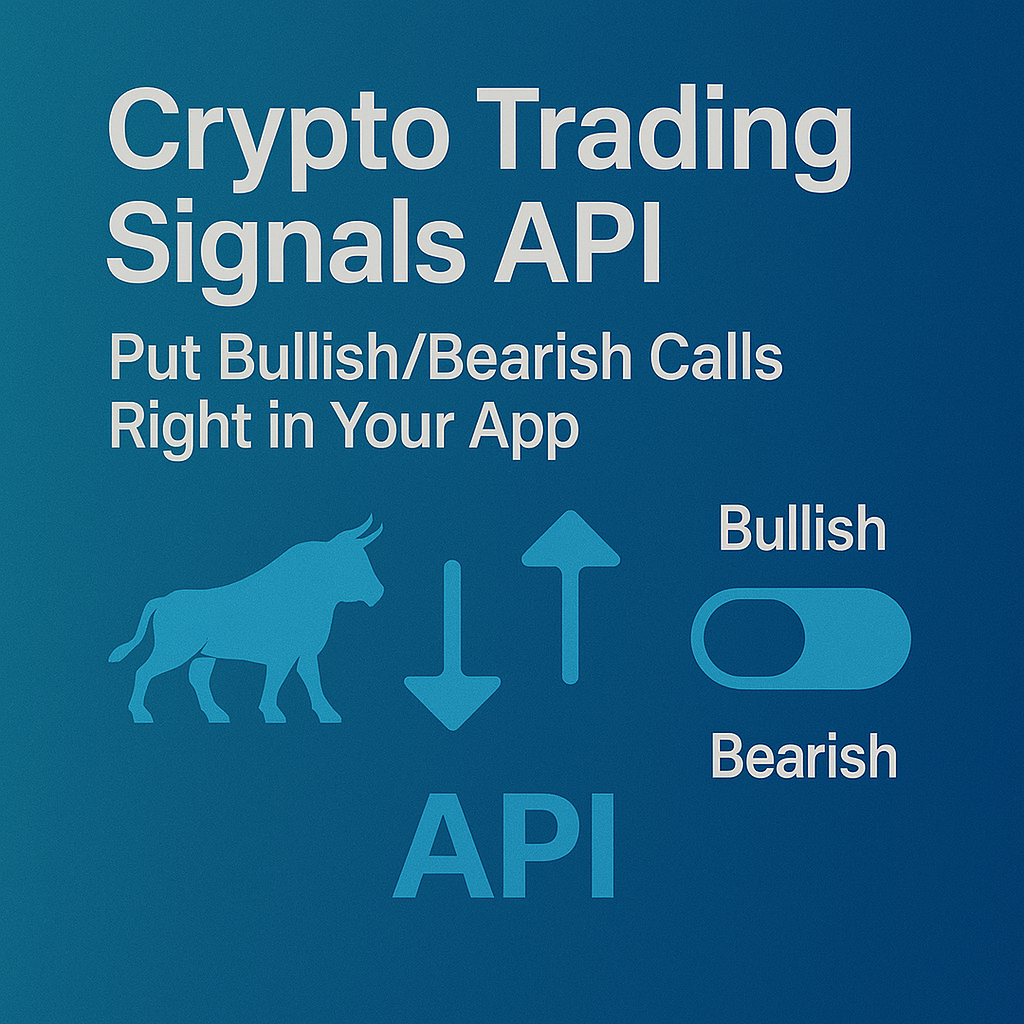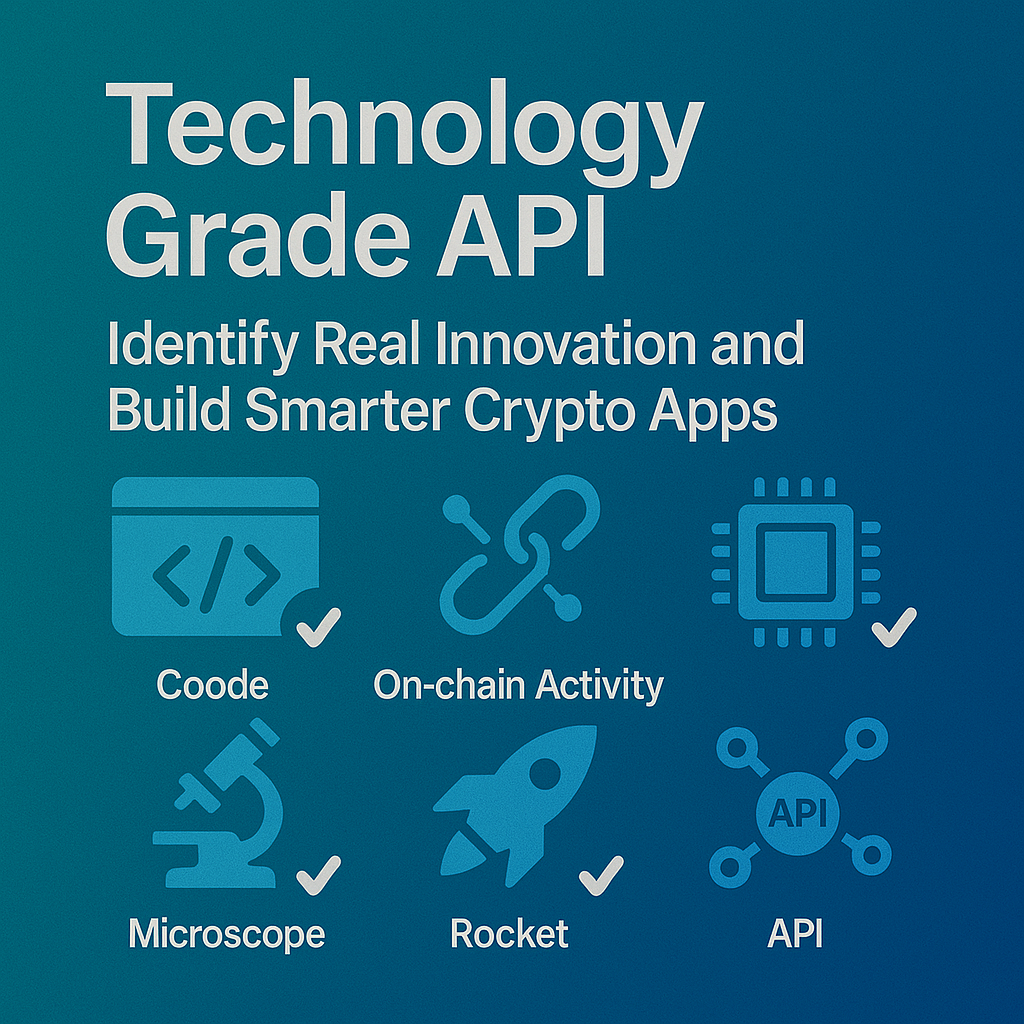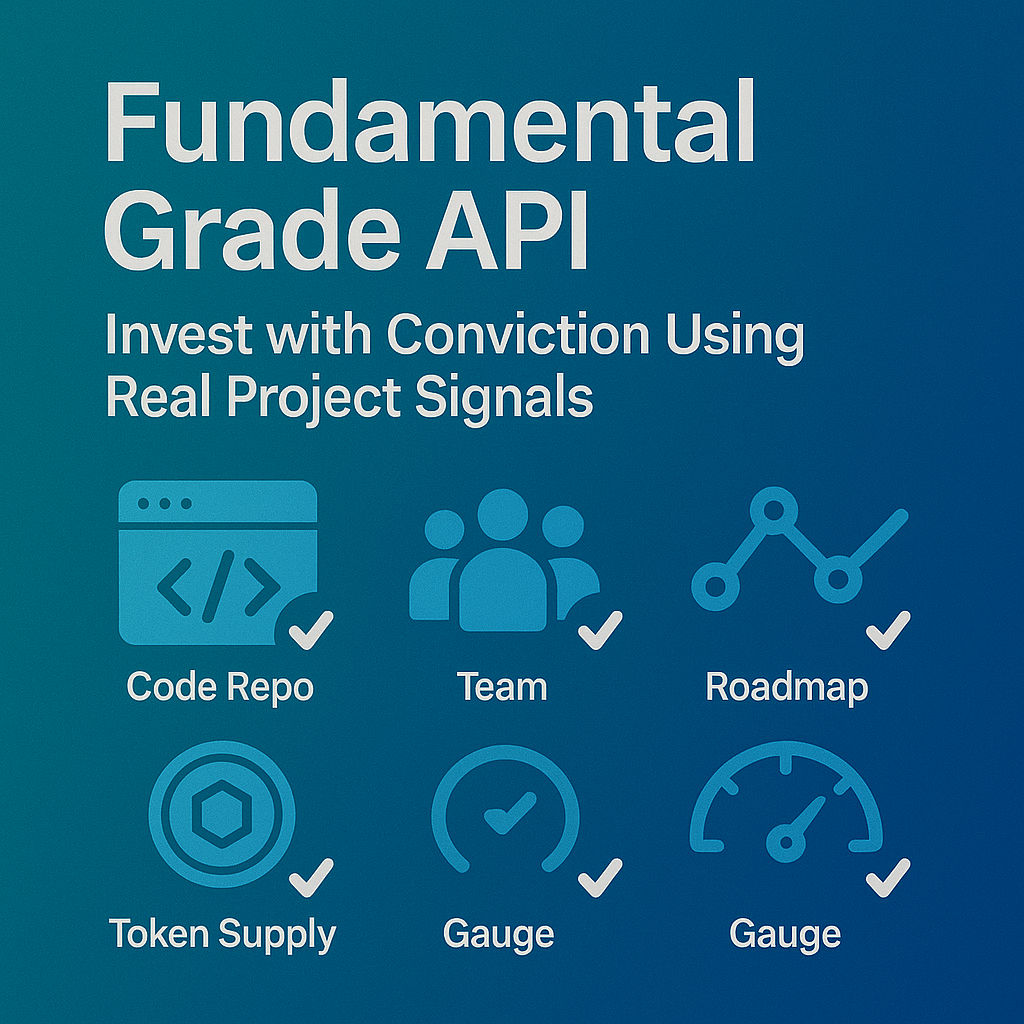Top Crypto Trading Platforms in 2025







%201.svg)
%201.svg)
Big news: We’re cranking up the heat on AI-driven crypto analytics with the launch of the Token Metrics API and our official SDK (Software Development Kit). This isn’t just an upgrade – it's a quantum leap, giving traders, hedge funds, developers, and institutions direct access to cutting-edge market intelligence, trading signals, and predictive analytics.
Crypto markets move fast, and having real-time, AI-powered insights can be the difference between catching the next big trend or getting left behind. Until now, traders and quants have been wrestling with scattered data, delayed reporting, and a lack of truly predictive analytics. Not anymore.
The Token Metrics API delivers 32+ high-performance endpoints packed with powerful AI-driven insights right into your lap, including:
Getting started with the Token Metrics API is simple:
At Token Metrics, we believe data should be decentralized, predictive, and actionable.
The Token Metrics API & SDK bring next-gen AI-powered crypto intelligence to anyone looking to trade smarter, build better, and stay ahead of the curve. With our official SDK, developers can plug these insights into their own trading bots, dashboards, and research tools – no need to reinvent the wheel.
%201.svg)
%201.svg)
Hype is loud, but code is what lasts. The Technology Grade API helps you measure the engineering strength behind a token—scalability, innovation, and real code quality—so you can prioritize serious projects in your bots, dashboards, or research tools. In this guide, you’ll query the /v2/technology-grade endpoint, embed the score in your UI, and ship a feature that turns technical due diligence into a single actionable signal. Start by grabbing your key at Get API Key, Run Hello-TM to validate your first call, then Clone a Template to go live fast.
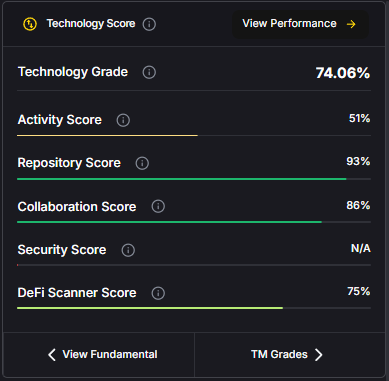
Separate hype from substance. Whitepapers and roadmaps are cheap; shipped code, throughput, and upgrade cadence are not. The Technology Grade API rolls engineering reality into a comparable score so you can rank ecosystems, filter listings, and surface projects with staying power.
Faster diligence, clearer decisions. For bot builders, Technology Grade is an upstream filter that keeps low-quality projects out of your universe. For dashboard builders, it adds credibility—users can see why a project ranks well. And for screeners, it’s a one-score signal that’s easy to sort, badge, and alert on with low latency.
For the Technology Grade information, check the top right of the API Reference. You'll find the cURL request to connect effortlessly.
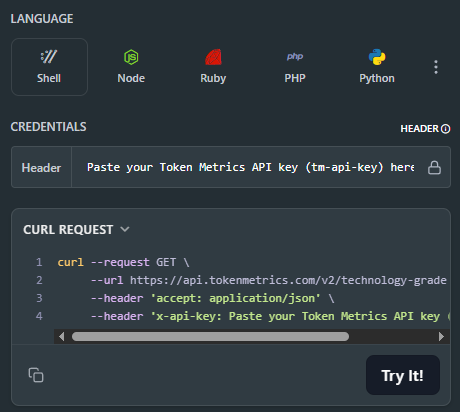
Kick off from quickstarts in the docs—fork a dashboard or screener and deploy. Validate your environment with Run Hello-TM, then scale usage. When you need higher limits and SLAs, compare API plans.
Technology Grade synthesizes engineering-centric evidence—such as throughput/scalability, rate of innovation (feature velocity, upgrade cadence), and code quality (maintainability, robustness cues)—into a normalized score and grade (e.g., Strong / Average / Weak). It’s designed to be comparable across projects and stable enough to inform filters, tiers, and badges.
At query time, you request /v2/technology-grade?symbol=<ASSET>. The response includes the headline score and component scores you can display in bars or a radar chart. For dashboards with many assets, use batched calls and short-TTL caching. If you push upgrade/downgrade alerts, queue notifications or use webhooks to avoid bursty polling.
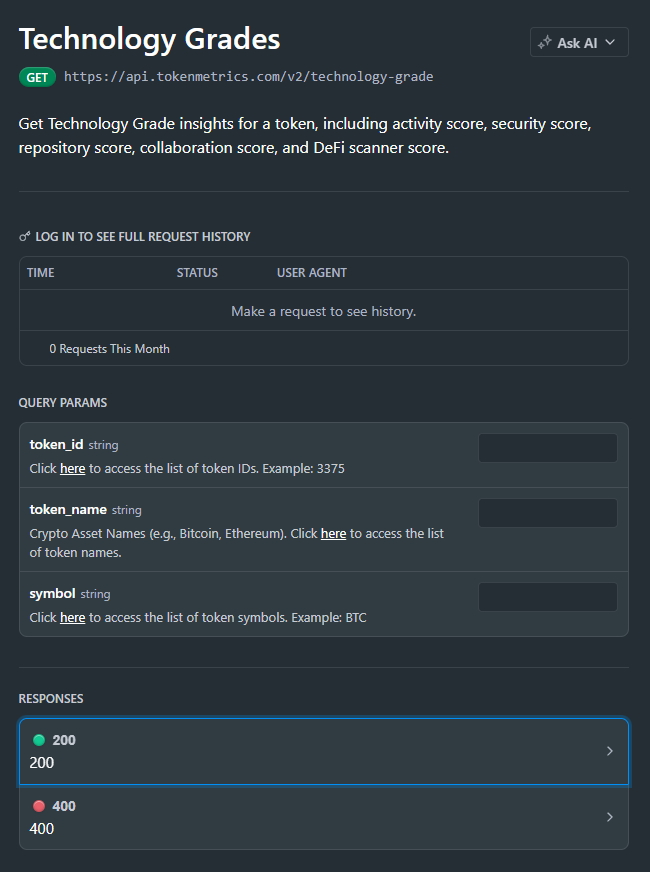
1) What does the Technology Grade API return?
A JSON payload with an overall score/grade plus component scores (e.g., scalability, innovation, code quality) and timestamps. Use the overall score for ranking and components for explanation.
2) Is this real-time, and what about latency/SLOs?
The endpoint is engineered for predictable latency suitable for dashboards and filters. For frequent refresh or alerts, combine short-TTL caching with queued jobs or webhooks to minimize round-trips.
3) How should I combine Technology Grade with other signals?
A common pattern: Technology Grade (engineering quality) + Fundamental Grade (business quality) + TM Grade (technicals/sentiment) + Trading Signals (timing) + Support/Resistance (risk placement).
4) How “accurate” is Technology Grade?
It’s an opinionated synthesis of engineering evidence, not financial advice. Use it as part of a diversified framework; validate with your own backtests and risk controls.
5) Do you provide SDKs or examples?
You can integrate via REST (JS/Python examples above). The docs include quickstarts, Postman collections, and templates—start by Run Hello-TM.
6) Polling vs webhooks for grade changes?
For UI pages, cached polling is fine. For alerts (upgrades/downgrades), prefer webhooks or scheduled jobs to avoid spiky traffic and rate-limit issues.
7) Pricing, limits, and enterprise SLAs?
Begin free and scale up as needed. See API plans for allowances; enterprise SLAs and support are available.
%201.svg)
%201.svg)
Most traders chase price action; Fundamental Grade API helps you see the business behind the token—community traction, tokenomics design, exchange presence, VC signals, and DeFi health—consolidated into one score you can query in code. In a few minutes, you’ll fetch Fundamental Grade, render it in your product, and ship a due-diligence UX that drives trust. Start by grabbing your key at the Get API Key page, Run Hello-TM to verify your first call, then Clone a Template to go live fast.
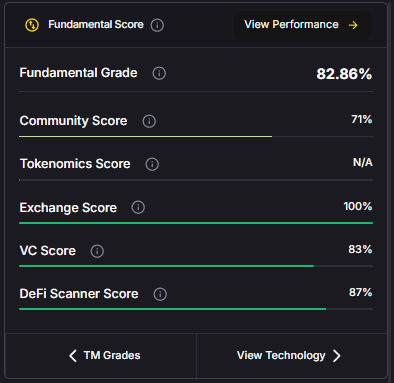
Beyond price, toward quality. Markets are noisy—hype rises and fades. Fundamental Grade consolidates hard-to-track signals (community growth, token distribution, liquidity venues, investor quality, DeFi integrations) into a clear, comparable score. You get a fast “is this worth time and capital?” answer for screening, allocation, and monitoring.
Build trust into your product. Whether you run an investor terminal, exchange research tab, or a portfolio tool, Fundamental Grade lets users justify positions. Pair it with TM Grade or Quantmetrics for a balanced picture: what to buy (fundamentals) and when to act (signals/levels).
The Fundamental Grade is easily accessible in the top right of the API Reference. Grab the cURL request for seamless access!
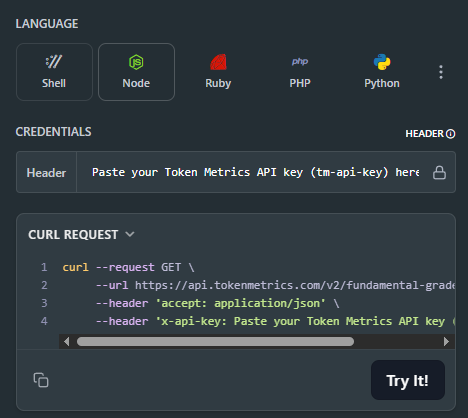
👉 Ready to build? Get API Key • Run Hello-TM • Clone a Template
Kick off from our quickstarts—fork a dashboard or screener template, plug your key, and deploy. If you’re new here, Run Hello-TM first to confirm your environment, then scale into product features. When you outgrow the free tier, compare API plans.
Fundamental Grade aggregates multiple project-quality signals into a normalized score and label (e.g., Strong / Average / Weak). Typical sub-signals include:
At query time, you call /v2/fundamental-grade with a symbol; responses include the overall score plus component scores you can visualize. For dashboards with many assets, batch fetches and short-TTL caching keep pages responsive. If you push alerts (e.g., “Fundamental Grade upgraded”), prefer webhooks or queued jobs to avoid hammering the API.
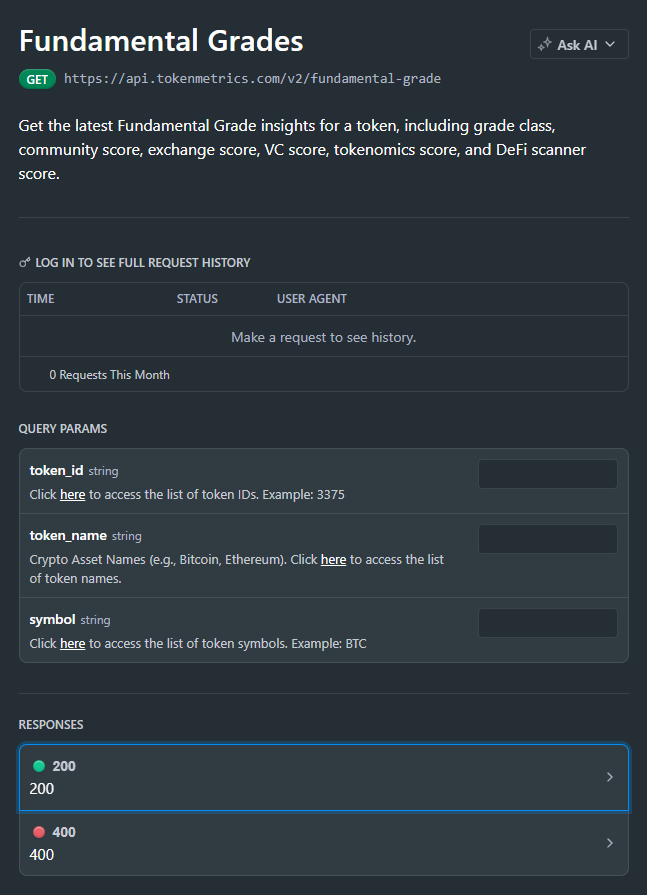
1) What does the Fundamental Grade API return?
A JSON payload with the overall score/grade plus component scores (e.g., community, tokenomics, exchange presence, VC backing, DeFi health) and timestamps. Use the overall grade for ranking and component scores for explanations.
2) How fast is the endpoint? Do you publish SLOs?
The API is engineered for predictable latency. For high-traffic dashboards, add short-TTL caching and batch requests; for alerts, use jobs/webhooks to minimize round-trips.
3) Can I combine Fundamental Grade with TM Grade or signals?
Yes. A common pattern is Fundamental Grade for quality filter + TM Grade for technical/sentiment context + Trading Signals for timing and Support/Resistance for risk placement.
4) How “accurate” is the grade?
It’s an opinionated synthesis of multiple inputs—not financial advice. Historical studies can inform usage, but past performance doesn’t guarantee future results. Always layer risk management and testing.
5) Do you offer SDKs and examples?
You can use REST directly (see JS/Python above). The docs include quickstarts, Postman, and ready-to-clone templates—start with Run Hello-TM.
6) Polling vs webhooks for fundamentals updates?
For UI pages, cached polling works well. For event-style notifications (upgrades/downgrades), prefer webhooks or scheduled jobs to avoid spiky traffic.
7) What about pricing, limits, and enterprise SLAs?
Begin free and scale as you grow. See API plans for allowances; enterprise SLAs and support are available—contact us.
%201.svg)
%201.svg)
Cluttered charts and whipsaw price action make it hard to act with conviction. The TM Grade API turns that noise into a single, opinionated signal you can build on—ideal for trading bots, dashboards, and research tools. In this guide, you’ll pull TM Grade in code, see how it powers products, and ship something useful in minutes. Start with the Get API Key, then Run Hello-TM in the docs and Clone a Template to go live fast.
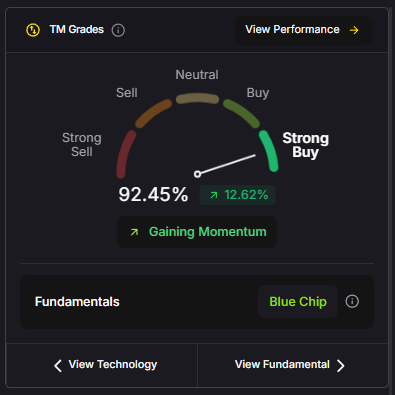
One score, clear decision. TM Grade distills technicals, sentiment, and momentum into a single, interpretable value from Strong Sell → Strong Buy. Instead of juggling indicators, you get an opinionated, trade-ready signal you can rank, alert on, and route into strategies.
Built for builders. Developers integrate TM Grade to filter universes, power dashboards, or trigger bots—with predictable performance and a schema designed for programmatic use. Pair it with webhooks and caching to slash latency and polling costs.
In the top right of the API Reference you can find the curl request for your desired language. This is what you can use to access the TM Grade endpoint.
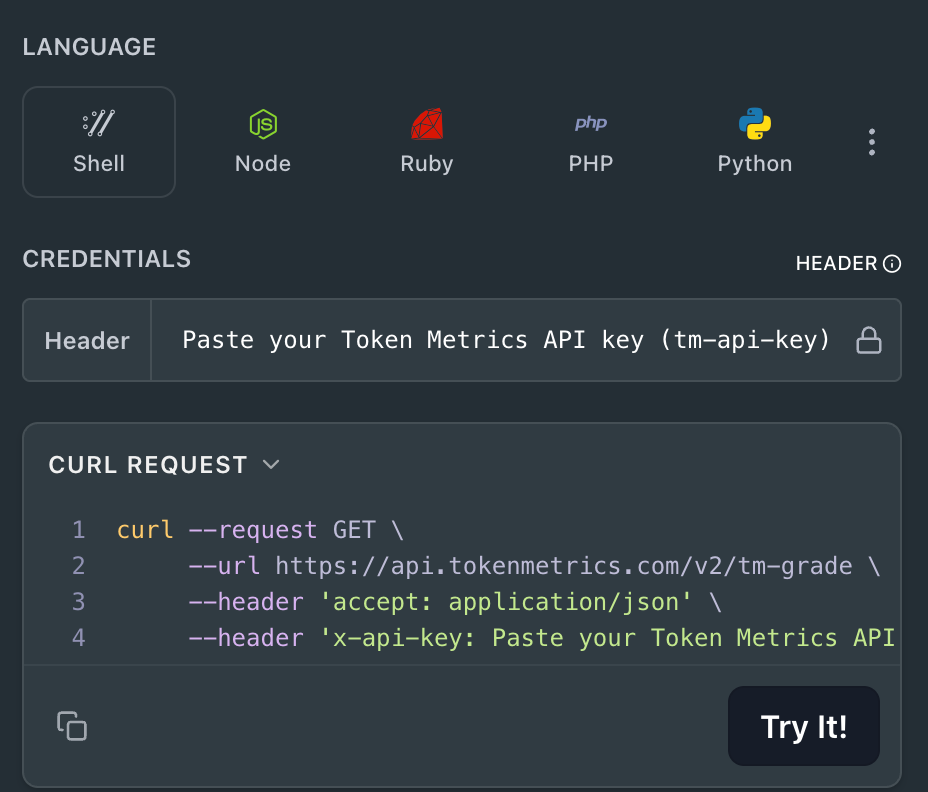
👉 Ready to go further? Get API Key • Run Hello-TM
You can start from our quickstarts in the docs—fork, plug your key, and deploy in minutes. Run Hello-TM to see the first call succeed, then scale into a bot or dashboard. When you’re ready for higher limits, compare API plans.
TM Grade blends multiple evidence streams—technical momentum, market structure, sentiment, and other model inputs—into a single normalized score (e.g., 0–100) and a label (Strong Sell to Strong Buy). This opinionated synthesis is what separates TM Grade from raw market data: it’s designed to be actionable.
Polling vs webhooks. For screens and dashboards, lightweight polling (or cached fetches) is fine. For trading agents and alerting, use webhooks or short polling with backoff and caching to cut latency and call volume. Combine TM Grade with endpoints like /v2/trading-signals for timing or /v2/resistance-support for risk placement.
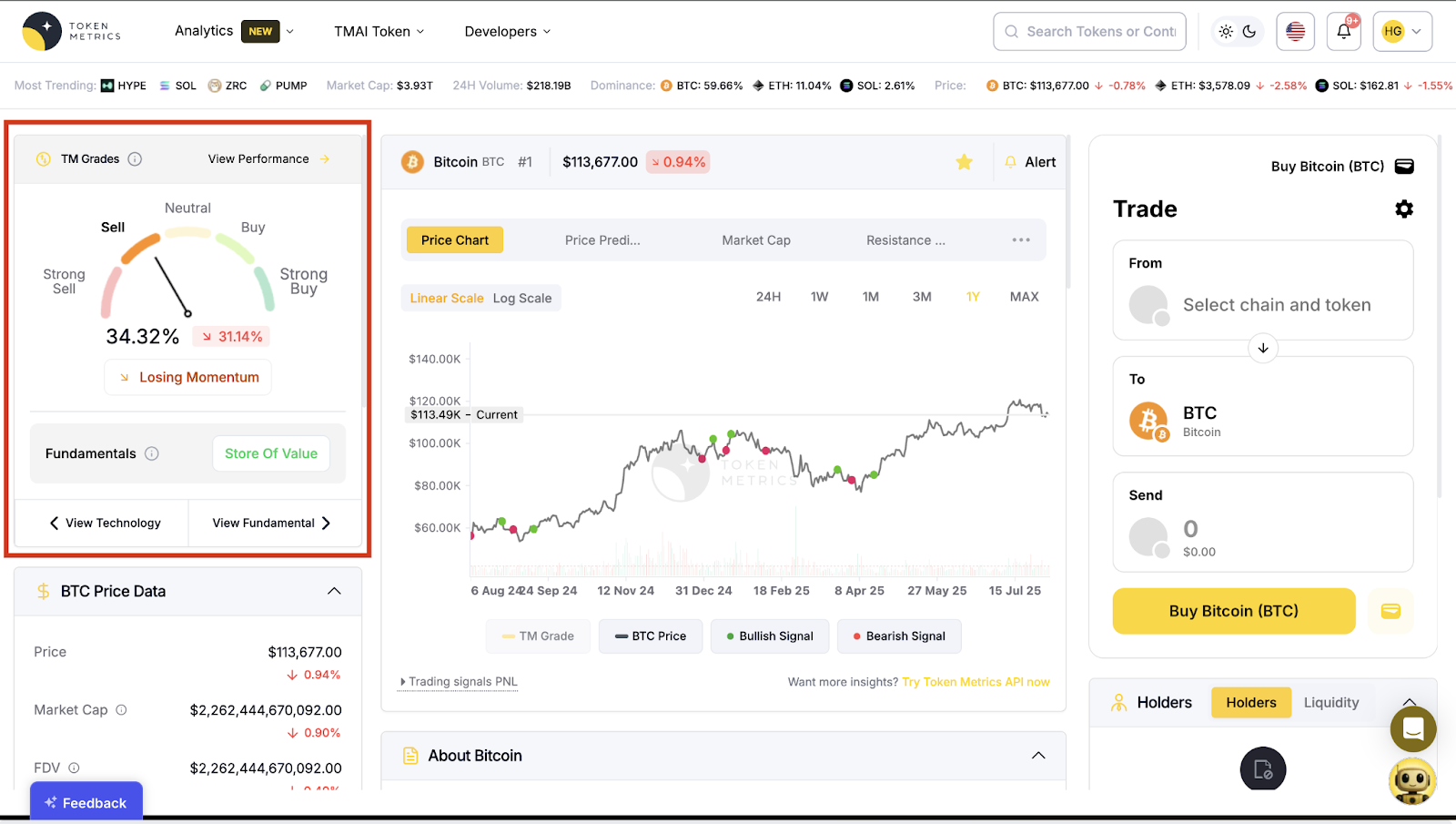
1) What does the TM Grade API return?
A JSON payload with fields like symbol, score (e.g., 0–100), and a categorical grade from Strong Sell to Strong Buy, designed for programmatic ranking, filtering, and display.
2) How fast is it? Do you have latency/SLOs?
TM endpoints are engineered for reliability with predictable latency. For mission-critical bots, add short-TTL caching and webhooks to minimize round-trips and jitter.
3) Can I use TM Grade in trading bots?
Yes. Many developers use TM Grade to pre-filter tokens and pair it with /v2/trading-signals for entries/exits. Always backtest and paper-trade before going live.
4) How accurate is TM Grade?
TM Grade is an opinionated model synthesizing multiple inputs. Backtests are illustrative—not guarantees. Use it as one component in a diversified strategy with risk controls.
5) Do you have SDKs and examples?
Yes—JavaScript and Python examples above, plus quickstarts and templates in the docs: Run Hello-TM.
6) Polling vs webhooks—what should I pick?
Dashboards: cache + light polling. Bots/alerts: prefer webhooks (or event-driven flows) to reduce latency and API usage.
7) Pricing, limits, and enterprise SLAs?
You can start free and scale up as you grow. See API plans for rate limits and tiers. Enterprise options and SLAs are available—contact us.

%201.svg)
%201.svg)
Centralized cryptocurrency exchanges have become the primary venues for trading a wide array of digital assets. Their user-friendly interfaces and liquidity pools make them appealing for both new and experienced traders. However, the inherent risks of using such centralized platforms warrant careful consideration. This article explores the risks associated with centralized exchanges, offering an analytical overview while highlighting valuable tools that can assist users in evaluating these risks.
Centralized exchanges (CEXs) operate as intermediaries that facilitate buying, selling, and trading cryptocurrencies. Users deposit funds into the exchange's custody and execute trades on its platform. Unlike decentralized exchanges, where users maintain control of their private keys and assets, centralized exchanges hold users' assets on their behalf, which introduces specific vulnerabilities and considerations.
One of the primary risks associated with centralized exchanges is security vulnerability. Holding large sums of digital assets in a single entity makes exchanges prominent targets for hackers. Over the years, numerous high-profile breaches have resulted in the loss of millions of dollars worth of crypto assets. These attacks often exploit software vulnerabilities, insider threats, or phishing campaigns.
Beyond external hacking attempts, users must be aware of the risks posed by potential internal malfeasance within these organizations. Since exchanges control private keys to user assets, trust in their operational security and governance practices is critical.
Using centralized exchanges means users relinquish direct control over their private keys. This custodial arrangement introduces counterparty risk, fundamentally differing from holding assets in self-custody wallets. In situations of insolvency, regulatory intervention, or technical failures, users may face difficulties accessing or retrieving their funds.
Additionally, the lack of comprehensive insurance coverage on many platforms means users bear the brunt of potential losses. The concept "not your keys, not your coins" encapsulates this risk, emphasizing that asset ownership and control are distinct on centralized platforms.
Centralized exchanges typically operate under jurisdictional regulations which can vary widely. Regulatory scrutiny may lead to sudden operational restrictions, asset freezes, or delisting of certain cryptocurrencies. Users of these platforms should be aware that regulatory changes can materially impact access to their assets.
Furthermore, compliance requirements such as Know Your Customer (KYC) and Anti-Money Laundering (AML) procedures involve sharing personal information, posing privacy considerations. Regulatory pressures could also compel exchanges to surveil or restrict user activities.
Large centralized exchanges generally offer high liquidity, facilitating quick trade execution. However, liquidity can vary significantly between platforms and tokens, possibly leading to slippage or failed orders during volatile conditions. In extreme scenarios, liquidity crunches may limit the ability to convert assets efficiently.
Moreover, centralized control over order books and matching engines means that trade execution transparency is limited compared to decentralized protocols. Users should consider market structure risks when interacting with centralized exchanges.
System outages, software bugs, or maintenance periods pose operational risks on these platforms. Unexpected downtime can prevent users from acting promptly in dynamic markets. Moreover, technical glitches could jeopardize order accuracy, deposits, or withdrawals.
Best practices involve users staying informed about platform status and understanding terms of service that govern incident responses. Awareness of past incidents can factor into decisions about trustworthiness.
While the risks highlighted are inherent to centralized exchanges, utilizing advanced research and analytical tools can enhance users’ understanding and management of these exposures. AI-driven platforms like Token Metrics offer data-backed insights into exchange security practices, regulatory compliance, liquidity profiles, and overall platform reputation.
Such tools analyze multiple risk dimensions using real-time data, historical performance, and fundamental metrics. This structured approach allows users to make informed decisions based on factual assessments rather than anecdotal information.
Additionally, users can monitor news, community sentiment, and technical analytics collectively via these platforms to evaluate evolving conditions that may affect centralized exchange risk profiles.
Centralized cryptocurrency exchanges continue to play a significant role in digital asset markets, providing accessibility and liquidity. Nevertheless, they carry multifaceted risks ranging from security vulnerabilities to regulatory uncertainties and operational challenges. Understanding these risks through a comprehensive analytical framework is crucial for all participants.
Non-investment-focused, AI-driven research platforms like Token Metrics can support users in navigating the complexity of exchange risks by offering systematic, data-driven insights. Combining such tools with prudent operational practices paves the way for more informed engagement with centralized exchanges.
This content is provided solely for educational and informational purposes. It does not constitute financial, investment, or legal advice. Readers should conduct their own research and consult qualified professionals before making any financial decisions.

%201.svg)
%201.svg)
The landscape of digital assets and blockchain technology has expanded rapidly over recent years, bringing forth a new realm known as Web3 alongside the burgeoning crypto ecosystem. For individuals curious about allocating resources into this sphere, questions often arise: should the focus be on cryptocurrencies or Web3 companies? This article aims to provide an educational and analytical perspective on these options, highlighting considerations without providing direct investment advice.
Before exploring the nuances between investing in crypto assets and Web3 companies, it's important to clarify what each represents.
Web3 companies often develop decentralized applications (dApps), offer blockchain-based services, or build infrastructure layers for the decentralized web.
Deciding between crypto assets or Web3 companies involves analyzing different dynamics:
To approach these complex investment types thoughtfully, frameworks can assist in structuring analysis:
Due to the rapidly evolving and data-intensive nature of crypto and Web3 industries, AI-powered platforms can enhance analysis by processing vast datasets and providing insights.
For instance, Token Metrics utilizes machine learning to rate crypto assets by analyzing market trends, project fundamentals, and sentiment data. Such tools support an educational and neutral perspective by offering data-driven research support rather than speculative advice.
When assessing Web3 companies, AI tools can assist with identifying emerging technologies, tracking developmental progress, and monitoring regulatory developments relevant to the decentralized ecosystem.
To gain a well-rounded understanding, consider the following steps:
Both crypto assets and Web3 companies involve unique risks that warrant careful consideration:
Deciding between crypto assets and Web3 companies involves analyzing different dimensions including technological fundamentals, market dynamics, and risk profiles. Employing structured evaluation frameworks along with AI-enhanced research platforms such as Token Metrics can provide clarity in this complex landscape.
It is essential to approach this domain with an educational mindset focused on understanding rather than speculative intentions. Staying informed and leveraging analytical tools supports sound comprehension of the evolving world of blockchain-based digital assets and enterprises.
This article is intended for educational purposes only and does not constitute financial, investment, or legal advice. Readers should conduct their own research and consult with professional advisors before making any decisions related to cryptocurrencies or Web3 companies.

%201.svg)
%201.svg)
The evolution from Web2 to Web3 marks a significant paradigm shift in how we interact with digital services. While Web2 platforms have delivered intuitive and seamless user experiences, Web3—the decentralized internet leveraging blockchain technology—still faces considerable user experience (UX) challenges. This article explores the reasons behind the comparatively poor UX in Web3 and the technical, design, and infrastructural hurdles contributing to this gap.
Web2 represents the current mainstream internet experience characterized by centralized servers, interactive social platforms, and streamlined services. Its UX benefits from consistent standards, mature design patterns, and direct control over data.
In contrast, Web3 aims at decentralization, enabling peer-to-peer interactions through blockchain protocols, decentralized applications (dApps), and user-owned data ecosystems. While promising increased privacy and autonomy, Web3 inherently introduces complexity in UX design.
Several intrinsic technical barriers impact the Web3 user experience:
The nascent nature of Web3 results in inconsistent and sometimes opaque design standards:
Web2 giants have invested billions over decades fostering developer communities, design systems, and customer support infrastructure. In contrast, Web3 is still an emerging ecosystem characterized by:
Such factors contribute to a user experience that feels fragmented and inaccessible to mainstream audiences.
Emerging tools powered by artificial intelligence and data analytics can help mitigate some UX challenges in Web3 by:
Integrating such AI-driven research and analytic tools enables developers and users to progressively enhance Web3 usability.
For users trying to adapt to Web3 environments, the following tips may help:
For developers, focusing on the following can improve UX outcomes:
The current disparity between Web3 and Web2 user experience primarily stems from decentralization complexities, immature design ecosystems, and educational gaps. However, ongoing innovation in AI-driven analytics, comprehensive rating platforms like Token Metrics, and community-driven UX improvements are promising. Over time, these efforts could bridge the UX divide to make Web3 more accessible and user-friendly for mainstream adoption.
This article is for educational and informational purposes only and does not constitute financial advice or an endorsement. Users should conduct their own research and consider risks before engaging in any blockchain or cryptocurrency activities.

%201.svg)
%201.svg)
Smart contracts have become an integral part of blockchain technology, enabling automated, trustless agreements across various platforms. Understanding what languages are used for smart contract development is essential for developers entering this dynamic field, as well as for analysts and enthusiasts who want to deepen their grasp of blockchain ecosystems. This article offers an analytical and educational overview of popular programming languages for smart contract development, discusses their characteristics, and provides insights on how analytical tools like Token Metrics can assist in evaluating smart contract projects.
Smart contract languages are specialized programming languages designed to create logic that runs on blockchains. The most prominent blockchain for smart contracts currently is Ethereum, but other blockchains have their languages as well. The following section outlines some of the most widely-used smart contract languages.
Developers evaluate smart contract languages based on various factors such as security, expressiveness, ease of use, and compatibility with blockchain platforms. Below are some important criteria:
Solidity remains the dominant language due to Ethereum's market position and is well-suited for developers familiar with JavaScript or object-oriented paradigms. It continuously evolves with community input and protocol upgrades.
Vyper has a smaller user base but appeals to projects requiring stricter security standards, as its design deliberately omits complex features that increase vulnerabilities.
Rust is leveraged by newer chains that aim to combine blockchain decentralization with high throughput and low latency. Developers familiar with systems programming find Rust a robust choice.
Michelson’s niche is in formal verification-heavy projects where security is paramount, such as financial contracts and governance mechanisms on Tezos.
Move and Clarity represent innovative approaches to contract safety and complexity management, focusing on deterministic execution and resource constraints.
Artificial Intelligence (AI) and machine learning have become increasingly valuable in analyzing and researching blockchain projects, including smart contracts. Platforms such as Token Metrics provide AI-driven ratings and insights by analyzing codebases, developer activity, and on-chain data.
Such tools facilitate the identification of patterns that might indicate strong development practices or potential security risks. While they do not replace manual code audits or thorough research, they support investors and developers by presenting data-driven evaluations that help in filtering through numerous projects.
Developers choosing a smart contract language should consider the blockchain platform’s restrictions and the nature of the application. Those focused on DeFi might prefer Solidity or Vyper for Ethereum, while teams aiming for cross-chain applications might lean toward Rust or Move.
Analysts seeking to understand a project’s robustness can utilize resources like Token Metrics for AI-powered insights combined with manual research, including code reviews and community engagement.
Security should remain a priority as vulnerabilities in smart contract code can lead to significant issues. Therefore, familiarizing oneself with languages that encourage safer programming paradigms contributes to better outcomes.
Understanding what languages are used for smart contract development is key to grasping the broader blockchain ecosystem. Solidity leads the field due to Ethereum’s prominence, but alternative languages like Vyper, Rust, Michelson, Move, and Clarity offer different trade-offs in security, performance, and usability. Advances in AI-driven research platforms such as Token Metrics play a supportive role in evaluating the quality and safety of smart contract projects.
This article is intended for educational purposes only and does not constitute financial or investment advice. Readers should conduct their own research and consult professionals before making decisions related to blockchain technologies and smart contract development.

%201.svg)
%201.svg)
With the increasing popularity of cryptocurrencies, selecting a trusted crypto exchange is an essential step for anyone interested in participating safely in the market. Crypto exchanges serve as platforms that facilitate the buying, selling, and trading of digital assets. However, the diversity and complexity of available exchanges make the selection process imperative yet challenging. This article delves into some trusted crypto exchanges, alongside guidance on how to evaluate them, all while emphasizing the role of analytical tools like Token Metrics in supporting well-informed decisions.
Crypto exchanges can broadly be categorized into centralized and decentralized platforms. Centralized exchanges (CEXs) act as intermediaries holding users’ assets and facilitating trades within their systems, while decentralized exchanges (DEXs) allow peer-to-peer transactions without a central authority. Each type offers distinct advantages and considerations regarding security, liquidity, control, and regulatory compliance.
When assessing trusted crypto exchanges, several fundamental factors come into focus, including security protocols, regulatory adherence, liquidity, range of supported assets, user interface, fees, and customer support. Thorough evaluation of these criteria assists in identifying exchanges that prioritize user protection and operational integrity.
Security Measures: Robust security is critical to safeguarding digital assets. Trusted exchanges implement multi-factor authentication (MFA), cold storage for the majority of funds, and regular security audits. Transparency about security incidents and response strategies further reflects an exchange’s commitment to protection.
Regulatory Compliance: Exchanges operating within clear regulatory frameworks demonstrate credibility. Registration with financial authorities, adherence to Anti-Money Laundering (AML) and Know Your Customer (KYC) policies are important markers of legitimacy.
Liquidity and Volume: High liquidity ensures competitive pricing and smooth order execution. Volume trends can be analyzed via publicly available data or through analytics platforms such as Token Metrics to gauge an exchange’s activeness.
Range of Cryptocurrencies: The diversity of supported digital assets allows users flexibility in managing their portfolios. Trusted exchanges often list major cryptocurrencies alongside promising altcoins, with transparent listing criteria.
User Experience and Customer Support: A user-friendly interface and responsive support contribute to efficient trading and problem resolution, enhancing overall trust.
While numerous crypto exchanges exist, a few have earned reputations for trustworthiness based on their operational history and general acceptance in the crypto community. Below is an educational overview without endorsement.
These examples illustrate the diversity of trusted exchanges, highlighting the importance of matching exchange characteristics to individual cybersecurity preferences and trading needs.
The rapid evolution of the crypto landscape underscores the value of AI-driven research tools in navigating exchange assessment. Platforms like Token Metrics provide data-backed analytics, including exchange ratings, volume analysis, security insights, and user sentiment evaluation. Such tools equip users with comprehensive perspectives that supplement foundational research.
Integrating these insights allows users to monitor exchange performance trends, identify emerging risks, and evaluate service quality over time, fostering a proactive and informed approach.
Despite due diligence, crypto trading inherently involves risks. Common concerns linked to exchanges encompass hacking incidents, withdrawal delays, regulatory actions, and operational failures. Reducing exposure includes diversifying asset holdings, using hardware wallets for storage, and continuously monitoring exchange announcements.
Educational tools such as Token Metrics contribute to ongoing awareness by highlighting risk factors and providing updates that reflect evolving market and regulatory conditions.
Choosing a trusted crypto exchange requires comprehensive evaluation across security, regulatory compliance, liquidity, asset diversity, and user experience dimensions. Leveraging AI-based analytics platforms such as Token Metrics enriches the decision-making process by delivering data-driven insights. Ultimately, informed research and cautious engagement are key components of navigating the crypto exchange landscape responsibly.
This article is for educational purposes only and does not constitute financial, investment, or legal advice. Readers should conduct independent research and consult professionals before making decisions related to cryptocurrency trading or exchange selection.

%201.svg)
%201.svg)
Blockchain technology has rapidly evolved into a foundational innovation affecting many industries. For newcomers eager to understand the basics, finding reliable and informative platforms to ask beginner blockchain questions is essential. This guide explores where you can pose your questions, engage with experts, and leverage analytical tools to deepen your understanding.
Blockchain, despite its increasing adoption, remains a complex and multifaceted topic involving cryptography, decentralized networks, consensus mechanisms, and smart contracts. Beginners often require clear explanations to grasp fundamental concepts. Asking questions helps clarify misunderstandings, connect with experienced individuals, and stay updated with evolving trends and technologies.
Online communities are often the first port of call for learners. They foster discussion, provide resources, and offer peer support. Some trusted platforms include:
Several courses and online platforms integrate Q&A functionalities to help learners ask questions in context, such as:
Advanced tools now assist users in analyzing blockchain projects and data, complementing learning and research efforts. Token Metrics is an example of an AI-powered platform that provides ratings, analysis, and educational content about blockchain technologies.
By using such platforms, beginners can strengthen their foundational knowledge through data-backed insights. Combining this with community Q&A interactions enhances overall understanding.
To get useful responses, consider these tips when posting questions:
Besides Q&A, structured learning is valuable. Consider:
This article is intended solely for educational purposes and does not constitute financial, investment, or legal advice. Always conduct independent research and consult professional advisors before making decisions related to blockchain technology or cryptocurrency.

%201.svg)
%201.svg)
The emergence of Web3 technologies has transformed the digital landscape, introducing decentralized applications, blockchain-based protocols, and novel governance models. For participants and observers alike, understanding how to measure success in Web3 projects remains a complex yet critical challenge. Unlike traditional businesses, where financial indicators are predominant, Web3 ventures often require multifaceted assessment frameworks that capture technological innovation, community engagement, and decentralization.
This article delves into the defining success factors for Web3 projects, offering a structured exploration of the key performance metrics, analytical frameworks, and tools available, including AI-driven research platforms such as Token Metrics. Our goal is to provide a clear, educational perspective on how participants and researchers can evaluate Web3 initiatives rigorously and holistically.
Success within Web3 projects is inherently multidimensional. While financial performance and market capitalization remain important, other dimensions include:
These factors may vary in relevance depending on the project type—be it DeFi protocols, NFTs, layer-one blockchains, or decentralized autonomous organizations (DAOs). Thus, establishing clear, context-specific benchmarks is essential for effective evaluation.
Below are critical performance indicators broadly used to gauge Web3 success. These metrics provide quantifiable insights into various aspects of project health and growth.
Systematic evaluation benefits from established frameworks:
Combining these frameworks with data-driven metrics allows for comprehensive, nuanced insights into project status and trajectories.
Artificial intelligence and machine learning increasingly support the evaluation of Web3 projects by processing vast datasets and uncovering patterns not readily apparent to human analysts. Token Metrics exemplifies this approach by offering AI-driven ratings, risk assessments, and project deep-dives that integrate quantitative data with qualitative signals.
These platforms aid in parsing complex variables such as token velocity, developer momentum, and community sentiment, providing actionable intelligence without subjective bias. Importantly, using such analytical tools facilitates continuous monitoring and reassessment as Web3 landscapes evolve.
For individuals or organizations assessing the success potential of Web3 projects, these steps are recommended:
While metrics and frameworks aid evaluation, it is essential to recognize the dynamic nature of Web3 projects and the ecosystem's inherent uncertainties. Metrics may fluctuate due to speculative behavior, regulatory shifts, or technological disruptions. Moreover, quantifiable indicators only capture parts of the overall picture, and qualitative factors such as community values and developer expertise also matter.
Therefore, success measurement in Web3 should be viewed as an ongoing process, employing diverse data points and contextual understanding rather than static criteria.
Measuring success in Web3 projects requires a multidimensional approach combining on-chain metrics, community engagement, development activity, and security considerations. Frameworks such as fundamental and scenario analysis facilitate structured evaluation, while AI-powered platforms like Token Metrics provide advanced tools to support data-driven insights.
By applying these methods with a critical and educational mindset, stakeholders can better understand project health and longevity without relying on speculative or financial advice.
This article is for educational and informational purposes only. It does not constitute financial, investment, or legal advice. Readers should conduct their own research and consult professionals before making decisions related to Web3 projects.

%201.svg)
%201.svg)
Smart contracts are self-executing contracts with the terms of the agreement directly written into lines of code. They run on blockchain platforms, such as Ethereum, enabling decentralized, automated agreements that do not require intermediaries. Understanding how to write a smart contract involves familiarity with blockchain principles, programming languages, and best practices for secure and efficient development.
Before diving into development, it is essential to grasp what smart contracts are and how they function within blockchain ecosystems. Essentially, smart contracts enable conditional transactions that automatically execute when predefined conditions are met, providing transparency and reducing dependency on third parties.
These programs are stored and executed on blockchain platforms, making them immutable and distributed, which adds security and reliability to the contract's terms.
Writing a smart contract starts with selecting an appropriate blockchain platform. Ethereum is among the most widely used platforms with robust support for smart contracts, primarily written in Solidity—a statically-typed, contract-oriented programming language.
Other platforms like Binance Smart Chain, Polkadot, and Solana also support smart contracts with differing languages and frameworks. Selecting a platform depends on the project requirements, intended network compatibility, and resource accessibility.
The most commonly used language for writing Ethereum smart contracts is Solidity. It is designed to implement smart contracts with syntax similar to JavaScript, making it approachable for developers familiar with web programming languages.
Other languages include Vyper, a pythonic language focusing on security and simplicity, and Rust or C++ for platforms like Solana. Learning the syntax, data types, functions, and event handling of the chosen language is foundational.
Development of smart contracts typically requires a suite of tools for editing, compiling, testing, and deploying code:
Writing a smart contract involves structuring the code to define its variables, functions, and modifiers. Key steps include:
contract to declare the contract and its name.Example snippet in Solidity:
pragma solidity ^0.8.0;
contract SimpleStorage {
uint storedData;
function set(uint x) public {
storedData = x;
}
function get() public view returns (uint) {
return storedData;
}
}Testing is crucial to ensure smart contracts operate as intended and to prevent bugs or vulnerabilities. Strategies include:
Adopting rigorous testing can reduce the risk of exploits or loss of funds caused by contract errors.
Deployment involves publishing the compiled smart contract bytecode to the blockchain. This includes:
Using test networks like Ropsten, Rinkeby, or Goerli is recommended for initial deployment to validate functionality without incurring real costs.
Emerging AI-driven platforms can assist developers and analysts with smart contract evaluation, security analysis, and market sentiment interpretation. For instance, tools like Token Metrics provide algorithmic research that can support understanding of blockchain projects and smart contract implications in the ecosystem.
Integrating these tools along with manual audits aids comprehensive assessments for better development decisions.
Writing secure smart contracts requires awareness of common vulnerabilities such as reentrancy attacks, integer overflows, and improper access controls. Best practices include:
Robust security practices are critical due to the immutable nature of deployed smart contracts on blockchain.
Writing a smart contract involves a combination of blockchain knowledge, programming skills, and adherence to security best practices. From choosing a platform and language to coding, testing, and deploying, each step plays an important role in the development lifecycle.
Leveraging AI-powered tools like Token Metrics can add valuable insights for developers aiming to enhance their understanding and approach to smart contract projects.
All information provided in this article is for educational purposes only and does not constitute financial or investment advice. Readers should conduct their own research and consult professional sources where appropriate.

%201.svg)
%201.svg)
Decentralized Autonomous Organizations (DAOs) represent an innovative model for decentralized governance and decision-making in the blockchain space. With the increasing integration of artificial intelligence (AI) into DAOs for automating processes and enhancing efficiency, it is vital to understand the risks associated with allowing AI to control or heavily influence DAOs. This article provides a comprehensive analysis of these risks, exploring technical, ethical, and systemic factors. Additionally, it outlines how analytical platforms like Token Metrics can support informed research around such emerging intersections.
DAOs are blockchain-based entities designed to operate autonomously through smart contracts and collective governance, without centralized control. AI technologies can offer advanced capabilities by automating proposal evaluation, voting mechanisms, or resource allocation within these organizations. While this combination promises increased efficiency and responsiveness, it also introduces complexities and novel risks.
One significant category of risks involves technical vulnerabilities arising from AI integration into DAOs:
Integrating AI into DAO governance raises complex questions around control, transparency, and accountability:
The autonomous nature of AI presents unique security concerns:
Beyond technical risks, the interaction between AI and DAOs also introduces ethical and regulatory considerations:
Understanding and managing these risks require robust research and analytical frameworks. Platforms such as Token Metrics provide data-driven insights supporting comprehensive evaluation of blockchain projects, governance models, and emerging technologies combining AI and DAOs.
The fusion of AI and DAOs promises innovative decentralized governance but comes with substantial risks. Technical vulnerabilities, governance challenges, security threats, and ethical concerns highlight the need for vigilant risk assessment and careful integration. Utilizing advanced research platforms like Token Metrics enables more informed and analytical approaches for stakeholders navigating this evolving landscape.
This article is for educational purposes only and does not constitute financial, legal, or investment advice. Readers should perform their own due diligence and consult professionals where appropriate.


 Create Your Free Account
Create Your Free Account9450 SW Gemini Dr
PMB 59348
Beaverton, Oregon 97008-7105 US
.svg)




.png)
Token Metrics Media LLC is a regular publication of information, analysis, and commentary focused especially on blockchain technology and business, cryptocurrency, blockchain-based tokens, market trends, and trading strategies.
Token Metrics Media LLC does not provide individually tailored investment advice and does not take a subscriber’s or anyone’s personal circumstances into consideration when discussing investments; nor is Token Metrics Advisers LLC registered as an investment adviser or broker-dealer in any jurisdiction.
Information contained herein is not an offer or solicitation to buy, hold, or sell any security. The Token Metrics team has advised and invested in many blockchain companies. A complete list of their advisory roles and current holdings can be viewed here: https://tokenmetrics.com/disclosures.html/
Token Metrics Media LLC relies on information from various sources believed to be reliable, including clients and third parties, but cannot guarantee the accuracy and completeness of that information. Additionally, Token Metrics Media LLC does not provide tax advice, and investors are encouraged to consult with their personal tax advisors.
All investing involves risk, including the possible loss of money you invest, and past performance does not guarantee future performance. Ratings and price predictions are provided for informational and illustrative purposes, and may not reflect actual future performance.

